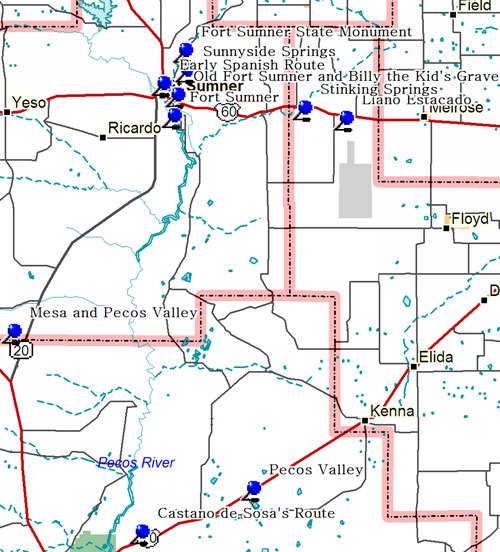
In 1590-91 Gaspar Castano de Sosa, a Portuguese by birth, took an expedition up the Pecos River in an attempt to establish a colony in New Mexico. His venture was a failure, but it led to a permanent settlement under Don Juan de Onate in 1598. Castano de Sosa passed near here in the winter of 1590.
In 1582, Antonio de Espejo and his exploring party left New Mexico to return to Mexico by way of the Pecos River. Eight years later, Gaspar Castano de Sosa led another group into New Mexico alongside the same river, a route little used again until the Territorial period.
Named for the fort built in 1862 to guard the Bosque Redondo Indian Reservation, the town of Fort Sumner grew out of settlements clustering around the Maxwell family properties. It moved to its present site with the construction of the Belen Cutoff of the Santa Fe Railroad around 1907.
Fort Sumner was built to guard captive Indians confined to the Bosque Redondo Reservation. About 8000 were Navajos relocated from Arizona but there were also over 400 Mescalero Apaches. The fort was abandoned in 1868 when the Indians were allowed to return home. Lucien B. Maxwell and Billy the Kid figure in its later history.
Pecos Valley section of Great Plains province stretches westward to foothills of Capitan, Jicarilla, and Gallinas Mountains. Southern High Plains, 50 miles to east, are capped by water-bearing Ogalalla Formation; Poguita Mesa to east is Ogalalla remnant. Nearby depressions are sinkholes in porous Permian limestones.
Fort Sumner was established in 1862 to guard the Navajo and Apaches on the Bosque Redondo Reservation. It was discontinued as a military post in 1868 and the buildings and site sold to Lucien B. Maxwell. William "Billy the Kid" Bonney was killed here by Sheriff Pat Garrett the night of July 14, 1881. Bonney is buried in the nearby cemetery.
Nearby is a "sweet water" spring which has been used through the centuries by Plains Indians, Spanish Explorers, and most recently, ranchers and settlers. A stagecoach station was located at the spring, which was named after Sunnyside, the nearby settlement whose name was changed to Fort Sumner in 1910.
|
